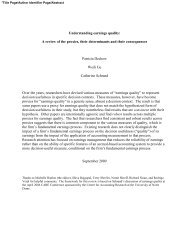Nike Considered: Getting Traction on Sustainability - MIT Sloan ...
Nike Considered: Getting Traction on Sustainability - MIT Sloan ...
Nike Considered: Getting Traction on Sustainability - MIT Sloan ...
Create successful ePaper yourself
Turn your PDF publications into a flip-book with our unique Google optimized e-Paper software.
NIKE CONSIDERED: GETTING TRACTION ON SUSTAINABILITY<br />
Rebecca Henders<strong>on</strong>, Richard M. Locke, Christopher Lyddy, Cate Reavis<br />
company’s denial not <strong>on</strong>ly failed to silence the critics, but “if anything, it raised the volume higher.” 12<br />
Ultimately, CEO Phil Knight acknowledged in a 1998 Nati<strong>on</strong>al Press Club Speech that “the <str<strong>on</strong>g>Nike</str<strong>on</strong>g><br />
product has become syn<strong>on</strong>ymous with slave wages, forced overtime, and arbitrary abuse.” 13<br />
Eventually <str<strong>on</strong>g>Nike</str<strong>on</strong>g> began addressing its labor issues in a more strategic way. In 1998, <str<strong>on</strong>g>Nike</str<strong>on</strong>g> c<strong>on</strong>solidated<br />
corporate resp<strong>on</strong>sibility functi<strong>on</strong>s under a new VP positi<strong>on</strong>, and began studying the reas<strong>on</strong>s behind its<br />
suppliers’ n<strong>on</strong>-compliance with its Code of C<strong>on</strong>duct. One c<strong>on</strong>clusi<strong>on</strong> that emerged was that <str<strong>on</strong>g>Nike</str<strong>on</strong>g>’s<br />
internal systems sometimes encouraged the very behaviors it wanted to eliminate. For example,<br />
procurement teams’ b<strong>on</strong>uses were set by price, quality, and delivery speed of orders, implicitly<br />
encouraging them to ignore suppliers’ code compliance. 14 By the late 1990s, <str<strong>on</strong>g>Nike</str<strong>on</strong>g> realized that<br />
corporate resp<strong>on</strong>sibility had to be a core part of <str<strong>on</strong>g>Nike</str<strong>on</strong>g>’s business, 15 a less<strong>on</strong> J<strong>on</strong>es took to heart in<br />
creating an envir<strong>on</strong>mental strategy.<br />
C<strong>on</strong>sidering the Envir<strong>on</strong>ment<br />
During the mid- and late-1990s, <str<strong>on</strong>g>Nike</str<strong>on</strong>g>’s labor issues c<strong>on</strong>sumed the attenti<strong>on</strong> of company leadership to<br />
the point where, as J<strong>on</strong>es noted, “It felt like all the oxygen had been sucked out of the room.”<br />
N<strong>on</strong>etheless, obscured and largely unnoticed because of the spotlight <strong>on</strong> labor issues, <str<strong>on</strong>g>Nike</str<strong>on</strong>g> employees<br />
had initiated a number of envir<strong>on</strong>mental programs. In the early 1990s, the company launched<br />
programs to replace the greenhouse gas SF6 in its flagship <str<strong>on</strong>g>Nike</str<strong>on</strong>g> Air system with climate-neutral<br />
nitrogen and develop water-based cements to replace toxic solvents, otherwise known as volatile<br />
organic compounds (VOCs). By 2000, <str<strong>on</strong>g>Nike</str<strong>on</strong>g> launched a company-wide training program centered <strong>on</strong><br />
product sustainability and initiated sustainability metrics. In 2005, inspired by the activity, <strong>on</strong>e<br />
footwear design team released a small line of more sustainable shoes which was called “<str<strong>on</strong>g>C<strong>on</strong>sidered</str<strong>on</strong>g>.”<br />
As the team’s developer explained it, the name came from the team “c<strong>on</strong>sidering what was right and<br />
doing what was right.”<br />
Enter Parker and J<strong>on</strong>es<br />
In December 2004, Hannah J<strong>on</strong>es assumed her new role as VP of Corporate Resp<strong>on</strong>sibility reporting<br />
to Mark Parker, who was then co-president of the <str<strong>on</strong>g>Nike</str<strong>on</strong>g> brand, and would so<strong>on</strong> become CEO of <str<strong>on</strong>g>Nike</str<strong>on</strong>g><br />
Inc. J<strong>on</strong>es had been with <str<strong>on</strong>g>Nike</str<strong>on</strong>g> since 1999 serving as the company’s CR Director in the Europe,<br />
Middle East, and Africa regi<strong>on</strong>, and previously worked as a producer for the BBC. Parker was a 27year<br />
<str<strong>on</strong>g>Nike</str<strong>on</strong>g> veteran and a designer at heart.<br />
Despite <str<strong>on</strong>g>Nike</str<strong>on</strong>g>’s various sustainability initiatives, envir<strong>on</strong>mental resp<strong>on</strong>sibility had not penetrated into<br />
<str<strong>on</strong>g>Nike</str<strong>on</strong>g>’s daily business decisi<strong>on</strong>s. Exploring why, <strong>on</strong>e of J<strong>on</strong>es’s first acts in her VP role was carrying<br />
12<br />
Sim<strong>on</strong> Zadek, “The Path to Corporate Resp<strong>on</strong>sibility,” Harvard Business Review, December 2004., p. 128.<br />
13<br />
Richard M. Locke, “The Promise and Perils of Globalizati<strong>on</strong>: The Case of <str<strong>on</strong>g>Nike</str<strong>on</strong>g>,” in Thomas A. Kochan and Richard L. Schmalensee, ed.,<br />
Management: Inventing and Delivering Its Future (<strong>MIT</strong> Press, Cambridge MA, 2003).<br />
14<br />
Sim<strong>on</strong> Zadek, “The Path to Corporate Resp<strong>on</strong>sibility,” Harvard Business Review, December 2004.<br />
15 Ibid.<br />
January 21, 2009 4
















